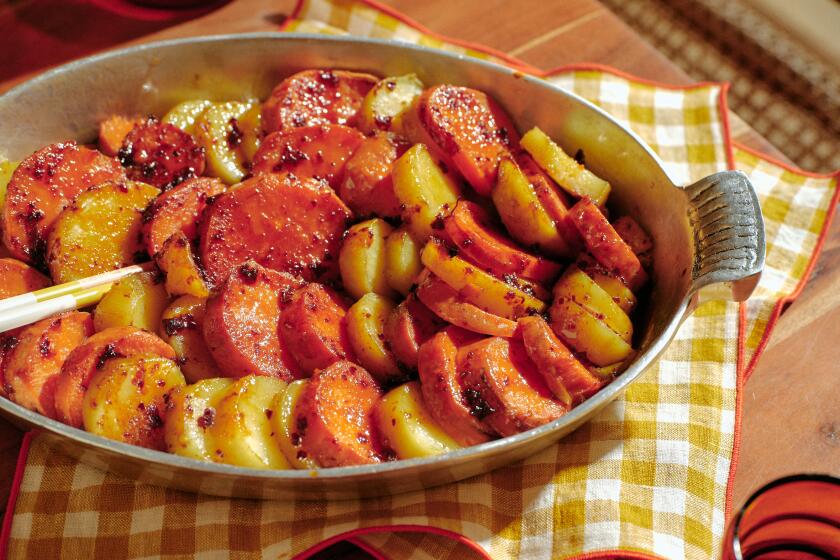White Bread
Made properly, this loaf will seed a lifelong love of bread. Its wheaten sweetness plays in our mouths. Its soft crust is gentle on our gums. It has a light acidity resulting from the use of a pre-fermented starter, which is then mixed into a fresher dough, formed into loaves and baked in the traditional manner. The mixing of the flour, water and salt well before the addition of the yeast in the main dough may sound eccentric, but it does much for the flavor. I have included measurements by weight, baker-style. This makes plain the proportion of ingredients for those who wish to adjust quantities.
Starter
Dissolve yeast in 2 teaspoons warm water and let stand 5 minutes.
Combine flour, salt, remaining water and yeast in large mixing bowl. Turn out on lightly floured board and knead 3 minutes. Return to bowl, cover with damp towel, store in plastic bag and allow to stand at room temperature until dough has doubled in size and smells quite yeasty, 4 to 5 hours.
Dough
Dissolve yeast in cup with 2 teaspoons warm water. Let stand until slightly creamy, about 15 minutes.
Mix flour, salt and water in large bowl until dough comes together. Turn onto lightly floured surface, knead for 3 minutes, dusting with flour to prevent sticking. Return to bowl and let it rest, covered by a damp towel, 15 minutes.
Add dissolved yeast and starter and knead in bowl to incorporate before turning out to knead on counter. Knead gently, folding, pressing and rolling dough--as opposed to pinning dough with heel of one hand and stretching with the other (this will tear the gluten structure, the protein strands that trap gas and allow the bread to rise). Treat dough like fabric you do not want to stress, much less rip.
Once the dough is smooth, resilient and has a buoyant, lively quality, after about 10 minutes, allow it to rise in a covered bowl for 30 minutes. Knock it down, then allow it to rise 1 hour. You should then have about enough dough for two (8-inch) loaf pans, but divide the dough to fit whatever pans you have, gently and very briefly folding and kneading each portion.
Fit dough into 2 (8-inch) loaf pans, which should be about half-filled with deflated dough. Cover with damp towels, place in plastic bag and allow dough a final rise, from 1 to 2 hours at room temperature. Rising time will vary according to how hot, or cool, your home is. It is ready to bake when dough has doubled in size.
Just before baking, score top of loaves down middle, about 1/2 inch deep, with a sharp knife. Working as quickly as possible, so oven door does not stand open too long, slip loaf pans in 475-degree oven. Reduce heat to 400 degrees. Depending on size of loaf pan, bake from 40 to 50 minutes.
For last 5 minutes of baking, remove pans from oven, knock out loaves and return to oven to finish crust. To test its doneness, tap around the side: It should make a hollow sound. Cool on wire rack. Bread is best rested for at least 2 hours after baking. It’s at its most delicious on day 2 and keeps 4 days, not that it often gets the chance.
Get our Cooking newsletter.
Your roundup of inspiring recipes and kitchen tricks.
You may occasionally receive promotional content from the Los Angeles Times.















